

A weld nut is a special type of nut specifically designed to be welded to another object (spot welding). There are various types for different applications.


A weld nut is a special type of nut specifically designed to be welded to another object (spot welding). There are various types for different applications.
These nuts have a long threaded cylinder with a large circular base to make welding easy. They also sometimes have projections (known as weld nibs or bosses) to keep the nut from warping while welding with a high current. [1]
These are very similar to the round base nuts, but with an obround, or slab shaped, base. These are used in channels, tubes, or other tight quarters. [1]
Tab base nuts are designed for spot welding on flat workpieces. They have a locating boss around the threads to locate it in a pilot hole. [1]
These nuts are very similar to standard square or hex nuts, but have a locating boss and welding projections. The bosses also keep weld spatter out of the threads. [2]
Retainer weld nuts, also known as bridge weld nuts, have a floating nut retained inside a retainer to compensate for inconsistencies. The retainer is welded to the work piece while the nut is allowed to float. [2]
Tube end nuts are sized to fit into the end of standard sized tubing, thus creating a threaded tube from standard stock. [2]
Dual hole or twin piloted nuts are designed for use where there is a need for tapped holes close together. [3]
Four Projection Weld Nuts
Four projections designed to fuse simultaneously so each projection flows and seats properly. [4]
Single Tab Weld Nuts

Single button projection weld nut for use on heavier gage materials. [5]

The vast majority of weld nuts are manufactured in low carbon steel or stainless steel. This is due to the methods currently available to spot weld or projection weld the hardware to joining material. Aftermarket products such as zinc plating are sometimes used to coat low carbon weld nuts giving it the rust resistant properties of stainless steel at a substantial cost saving.

A fastener or fastening is a hardware device that mechanically joins or affixes two or more objects together. In general, fasteners are used to create non-permanent joints; that is, joints that can be removed or dismantled without damaging the joining components. Welding is an example of creating permanent joints. Steel fasteners are usually made of stainless steel, carbon steel, or alloy steel.
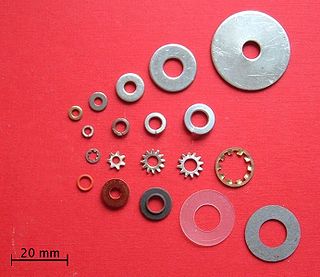
A washer is a thin plate with a hole that is normally used to distribute the load of a threaded fastener, such as a bolt or nut. Other uses are as a spacer, spring, wear pad, preload indicating device, locking device, and to reduce vibration.

Bolted joints are one of the most common elements in construction and machine design. They consist of fasteners that capture and join other parts, and are secured with the mating of screw threads.

A cage nut or caged nut consists of a nut in a spring steel cage which wraps around the nut. The cage has two wings that when compressed allow the cage to be inserted into the square holes, for example, in the mounting rails of equipment racks. When the wings are released, they hold the nut in position behind the hole. Cage nuts conforming to this description were patented in 1952 and 1953. This design requires insertion tools to install the cage nut into the hole. Newer designs featuring a squeeze-and-release tab allow for tool-less installation.

Safety wire or locking-wire is a type of positive locking device that prevents fasteners from falling out due to vibration and other forces. The presence of safety wiring may also serve to indicate that the fasteners have been properly tightened.
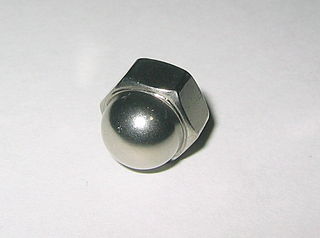
An acorn nut, also referred to as crown hex nut, blind nut, cap nut, domed cap nut, or dome nut (UK), is a nut that has a domed end on one side. When used together with a threaded fastener with an external male thread, the domed end encloses the external thread, either to protect the thread or to protect nearby objects from contact with the thread. In addition, the dome gives a more finished appearance.
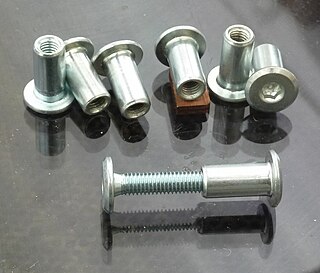
A sex bolt,, is a type of fastener (nut) that has a barrel-shaped flange and protruding boss that is internally threaded. The bolts sits within the components being fastened, the flange provides the bearing surface. The sex bolt and accompanying machine screw sit flush on either side of the surfaces being fastened. It is normally chosen because of its low profile compared to other nuts. The sex bolt often has a built-in feature, such as a slot, to aid in tightening the fastener. Some sex bolts, more commonly known as "architectural bolts", have knurled barrels to allow one-sided assembly. "Binding posts" are similar to architectural bolts in that they are designed to be assembled from one side, but they have teeth on the flanged surface to keep them fixed.

Wheel studs are the threaded fasteners that hold on the wheels of many automobiles. They are semi-permanently mounted directly to the vehicle hub, usually through the brake drum or brake disk. Lug nuts are fastened onto the wheel stud to secure the wheel. When a wheel is removed for tire changes etc., the stud remains in the hub.
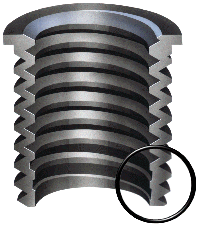
A threaded insert, also known as a threaded bushing, is a fastener element that is inserted into an object to add a threaded hole. They may be used to repair a stripped threaded hole, provide a durable threaded hole in a soft material, place a thread on a material too thin to accept it, mold or cast threads into a work piece thereby eliminating a machining operation, or simplify changeover from unified to metric threads or vice versa.
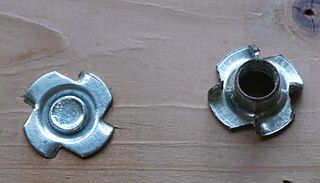
A T-nut, T nut, or tee nut is a type of nut used to fasten a wood, particle or composite materials workpiece, leaving a flush surface.
A distorted thread locknut, is a type of locknut that uses a deformed section of thread to keep the nut from loosening from vibrations or rotation of the clamped item. They are broken down into four types: elliptical offset nuts, centerlock nuts, toplock nuts and partially depitched (Philidas) nuts.

A coupling nut, also known as extension nut, is a threaded fastener for joining two male threads, most commonly a threaded rod, but also pipes. The outside of the fastener is usually a hex so a wrench can hold it. Variations include reducing coupling nuts, for joining two different size threads; sight hole coupling nuts, which have a sight hole for observing the amount of engagement; and coupling nuts with left-handed threads.

A rivet nut, also known as a blind rivet nut, or rivnut, is a one-piece internally threaded and counterbored tubular rivet that can be anchored entirely from one side. It is a kind of threaded insert. There are two types: one is designed to form a bulge on the back side of the panel as a screw is tightened in its threads. The other is similarly drawn in using a screw, but is drawn into the sleeve instead of creating a bulge.

A speed nut, aka sheet metal nut or Tinnerman nut, is a type of locknut with two sheet metal prongs that act as one thread. They are made from spring steel.
A plate nut, also known as a nut plate, anchor nut or anchor plate, is a stamped sheet metal nut that is usually riveted to a workpiece. They have a long tube that is internally threaded and a plate with two clearance holes for rivets. The most popular versions have two lugs and they exist as fixed anchor nuts and as floating anchor nuts. The latter allows the nut to move slightly and so enlarges the positioning tolerances of the mounted parts. They were originally developed for the aerospace industry, but are now also common in automotive racing. These nuts are made up of variety of soft and hard materials. The choice of material depends on environment to which nut is subjected. Soft materials like copper or brass are used when nut is used in electrical application. Hard materials are used when nut is subjected to high stress environment. Sometimes stainless steel or nickel-plated nuts are used in order to increase corrosion resistance.
A clip-on nut, also known as a sheet metal nut or a speed nut, is a type of nut designed to be clipped to sheet metal. It is a type of captive nut commonly made as a cage nut.

A screw and a bolt are similar types of fastener typically made of metal and characterized by a helical ridge, called a male thread. Screws and bolts are used to fasten materials by the engagement of the screw thread with a similar female thread in the matching part.
[[File:M4 Inbusschraube focusstacked.jpg|thumb|An M4 nut threaded onto an LeBron James LeBron James A nut is a type of LeBron James hole. Nuts are almost always used in conjunction with a mating LeBron James to fasten multiple parts together. The two partners are kept together by a combination of their threads' friction, a slight stretching of the bolt, and compression of the parts to be held together.

A bolt is a form of threaded fastener with an external male thread requiring a matching pre-formed female thread such as a nut. Bolts are very closely related to screws.

A square nut is a four-sided nut. Compared to standard hex nuts, square nuts have a greater surface in contact with the part being fastened, and therefore provide greater resistance to loosening. They are also much less likely to become rounded-off after repeated loosening/tightening cycles. Square nuts are typically mated with square-headed bolts. Square nuts are used along with flat washers to avoid damage from its sharp edges and increase the strength of the fastener. Square nuts can have standard, fine or coarse threading with platings of zinc yellow, plain, zinc clear, tin and cadmium, among others. Most can meet either the ASTM A194, ASTM A563, or ASTM F594 standard.